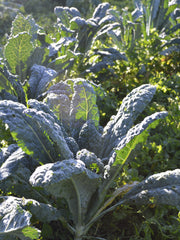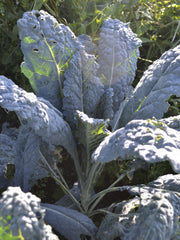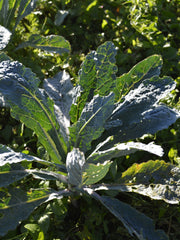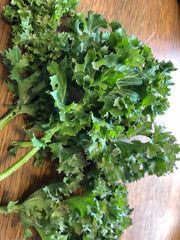Winter Red
HOW TO GROW SIBERIAN KALE
Start indoors 4-6 weeks before last frost, plant out 4 weeks before frost. For fall harvest, transplant 13 weeks before first frost, without additional protection. In a hoophouse, you can plant 2-3 weeks later. Plants are hardy when small but may not feed you until spring. Direct sow anytime after last frost up to 6 weeks before first frost. For seed production, plant in late summer in the Pacific Northwest and coastal British Columbia for a more cold hardy plant. Becomes sweeter with frost and edible to about 22–25˚F. Survival at low temps 10˚F or cooler requires good mulch or snow cover to protect from wind freeze. Will cross with rutabagas. Row covers reduce cabbage worms and extend winter harvest. Soil pH 6.1-6.5. Hardiness zones 3-9. Biennial.
Days from maturity calculated from the date of seeding. Average 9,000 seeds per ounce. Average 112M seeds per acre. Federal germination standard: 75%. Usual seed life: 5 years. Isolation distance for seed saving: 1 mile.
Planting Depth 1/4-1/2”
Soil Temp. Germ. 55-75˚F
Days to Germ. 5-15
Plant Spacing 12-18”
Row Spacing 18-30”
Days To Maturity 60-70
Full Sun, Moist Well Drained
Days from maturity calculated from the date of seeding. Average 9,000 seeds per ounce. Average 112M seeds per acre. Federal germination standard: 75%. Usual seed life: 5 years. Isolation distance for seed saving: 1 mile.
Planting Depth 1/4-1/2”
Soil Temp. Germ. 55-75˚F
Days to Germ. 5-15
Plant Spacing 12-18”
Row Spacing 18-30”
Days To Maturity 60-70
Full Sun, Moist Well Drained
Winter Red Seed Count
1 Ounce ≈ 6,300 seeds
A Red Russian-type kale developed by Tim Peters for good uniform color and cold hardiness. A tender salad kale, said to have a little wild mustard in its sap. Tags: Type: Siberian, Color: Bi-Colored, Heritage: Heirloom, Season: Spring Fall Winter, Certification: Organic.
Meet Your Farmer
We promote fair trade, organic practices and environmental responsibility throughout the Restoration Seeds supply chain. Below are the family farmers and seed suppliers who bring our open pollinated seeds to you.
Sugi Lumina Grace
Conventional
Seed grower since 2021


Gardening since age 8, I have always had a passion for plants. I began dedicating my energy toward wild-tending and homesteading with a focus on year-round food sustainability in 2006. Now settled in Ashland, Oregon, I have been enjoying adding the seed-saving cycle to my gardening season. I use only natural products in my small garden with a lot of manually tended care.My other work is as a massage therapist: Appointments | Sugi Lumina Grace, LLC
Reviews


















